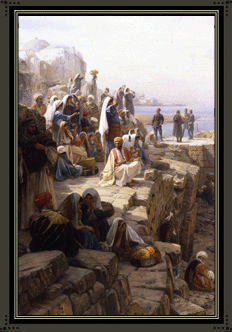
Museum Exhibits
January 29 to March 29, 2009: Napoleon on the Nile: Soldiers, Artists and the Rediscovery of Egypt
March 24 through April 30, 2009: In Pursuit of the Exotic: Artists Abroad in 19th Century Egypt and the Holy Land
New York, New York – The Dahesh Museum of Art and Syracuse University Art Galleries today announced the formation of a partnership, which will include the Museum’s organizing several exhibitions annually from its own collection of 19th-century art in the academic tradition, complemented by works in the University’s rich collection, for presentation at the SU Art Galleries in Syracuse, as well as The Palitz Gallery/ Lubin House, located on 11 East 61st Street, off Fifth Avenue. The Palitz Gallery has recently attracted artworld attention with the exhibition Michelangelo: the Man and the Myth on view through January 4th 2009.
The partnership is initially projected for two years and will include exhibitions at the Palitz Gallery in New York and the SU Art Galleries in Syracuse. The two institutions are also in discussion about additional collaborative ventures including programming, publications and educational outreach.
The launch of this collaboration is scheduled for New York City this spring. From March 24 through April 30, 2009, a focused selection of the Museum’s finest works will be featured in the exhibition, In Pursuit of the Exotic: Artists Abroad in 19th Century Egypt and the Holy Land. Curated by Dr. David Farmer, the exhibition explores how artists in that era depicted their expanding world. The most exotic destinations for Europeans at that time were Egypt and the Holy Land, which, for centuries, had been difficult to reach. Egypt offered a mysterious culture and monumental environment, while the Holy Land combined historical, religious connection with European tradition and an extraordinary visual “otherness.”
The second exhibition, the Museum’s critically acclaimed and immensely popular traveling show, Napoleon on the Nile: Soldiers, Artists and the Rediscovery of Egypt, will be on view at The Syracuse University Art Galleries from January 29 to March 29, 2009. It tells the story of Napoleon’s extraordinary scientific project to systematically explore, describe and document Egyptian civilization, as part of his brief, but ill-fated bid to add Egypt to the growing French Empire. Napoleon on the Nile features 80 large, exquisitely engraved plates drawn from the massive, encyclopedic compendium, The Description of Egypt, perhaps Napoleon’s greatest legacy, and offers visitors a rare encounter with the foundational work of modern Egyptology.
According to the Dahesh Museum of Art’s Director, Dr. Flora E.S. Kaplan, “We were honored to receive an invitation from Syracuse University to create exhibitions for a large audience of art lovers, both in Manhattan and at the University’s campus galleries in Syracuse. The Museum’s mission is to collect, exhibit, and interpret works by Europe’s academically-trained artists of the 19th and early 20th centuries. Our goal has always been to provide a fresh appraisal of the role academies played in reinvigorating classical ideals of beauty, humanism, and skill, and to trace that legacy as it influences artists today. Our exhibitions are framed by contemporary concerns and universal questions; they provide new ways of thinking about the role of art and artists in society, a vision we share with the SUArt Galleries. The University’s diverse collections will complement our own, and we hope to draw upon them in new, unexpected ways.”
According to Domenic Iacono, the Director of the SUArt Galleries, which encompasses the Palitz Gallery in New York, “Our objective was to expand our exhibition programming with quality displays developed from the Dahesh’s Collection and to provide an opportunity for each institution to work with one another. While the Dahesh Museum of Art’s collection numbers around 3,000 works, predominately focused on 19th and early 20th century European masters in the academic tradition, the collections of Syracuse University are very diverse, comprising more than 45,000 objects that include paintings, prints, sculpture, decorative and ethnographic arts from the 15th through 20th centuries. The Annie Walters Arents Collection of 19th-century Academic Paintings has many parallels with the Dahesh’s own collection.”
The partnership between Syracuse University and the Dahesh Museum offers each institution heightened visibility, new audiences, and the potential for dynamic collaborative programming. The Museum, which closed its doors on Madison and 56th Street almost a year ago, has not yet located a suitable permanent home, though it continues to travel its exhibitions and loan objects nationally and internationally. The partnership enables the Museum to mount new exhibitions in mid-Manhattan in Lubin House, a classic 19th century townhouse known for its focused, quality exhibitions, and to reconnect with its members, colleagues and devoted museum-goers. At the same time, the Palitz Gallery at Lubin House will be introduced to new audiences, while the students, faculty and diverse communities within Syracuse will be introduced to a new way of looking at and thinking about art in the context of history, an approach that the Dahesh Museum has pioneered in its short, 14-year history.
For now, the partnership is projected for two years, but there may be a long-term relationship in the future. “Especially in these challenging economic times,” says Domenic Iacono, “our two institutions will investigate other ways to collaborate.” Flora Kaplan agrees. “Our experiment is reaching out to and engaging new audiences. We see the partnership as fluid and look forward to working in new ways and on new projects.”
For the latest information on the exhibition in New York City, visit the Lubin House website, lubinhouse.syr.edu or daheshmuseum.org. For the exhibition in Syracuse, visit suart.syr.edu or http://daheshmuseum.org.